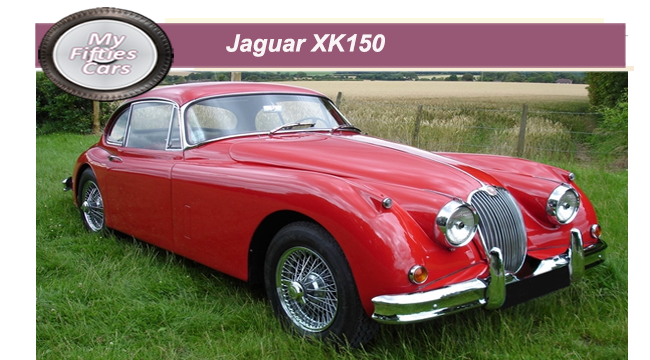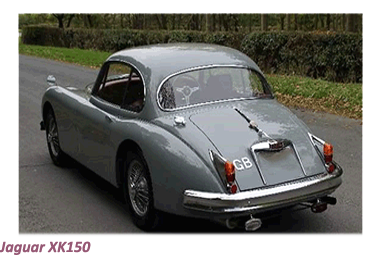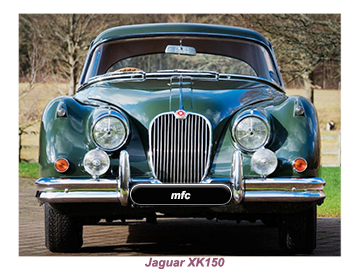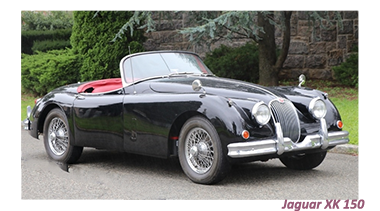
More substantial than its predecessors, and looking just a little overweight after the slender lines of the original XK120, the Jaguar XK150 gained a less distinctive higher waistline and a modern one-piece wraparound front windscreen.
 < At the same time, the car became much more refined, being more comfortable and more civilised to drive.
< At the same time, the car became much more refined, being more comfortable and more civilised to drive.
The continuation of the rear bench seat from the XK140 and the increased availability of the Borg-Warner automatic transmission underlined the fact that Jaguar wanted the car tote seen more as a grand tourer than an actual sports car.
 Dunlop disc brakes were fitted to all four wheels, and handling was more assured than that of the earlier XKs.
Dunlop disc brakes were fitted to all four wheels, and handling was more assured than that of the earlier XKs.
T he drophead coupe, with it's beautifully lined and trimmed hood, was heavier still, and despite efforts to keep weight down by making the XK150 bonnet and boot lid from aluminium, this version weighed in at a ponderous 1498.6kg (33041b).
he drophead coupe, with it's beautifully lined and trimmed hood, was heavier still, and despite efforts to keep weight down by making the XK150 bonnet and boot lid from aluminium, this version weighed in at a ponderous 1498.6kg (33041b).
With this burden of weight to carry, the research team at Jaguar soon arrived at the conclusion that the XK150 needed a more powerful engine.
![]()
 They came up with the 156kW (210bhp) Blue Top engine as an alternative to the 142kW (190bhp) unit. Those who opted for the 156kW unit did so in the knowledge that top speed would fall to 200km/h (125mph).
They came up with the 156kW (210bhp) Blue Top engine as an alternative to the 142kW (190bhp) unit. Those who opted for the 156kW unit did so in the knowledge that top speed would fall to 200km/h (125mph).
 In 1958, responding to some negative press in the motoring media that the XK 150 had become 'middle-aged', Jaguar took the bull by the horns, launching the S version fitted with an even more powerful 186kW (250bhp) engine.
In 1958, responding to some negative press in the motoring media that the XK 150 had become 'middle-aged', Jaguar took the bull by the horns, launching the S version fitted with an even more powerful 186kW (250bhp) engine.
From 1959, all cars were fitted with the 3.8-litre (232 cu in) engine, increasing power to 164kW (220bhp) (197kW [265bhp] on the S versions).
 Despite sharing the same twin-cam engine and stout chassis, the third and final member of the Jaguar XK family was more of a grand tourer than an out-and-out sports car, although it was the first Jaguar to go into production without the company investing in developing a new chassis.
Despite sharing the same twin-cam engine and stout chassis, the third and final member of the Jaguar XK family was more of a grand tourer than an out-and-out sports car, although it was the first Jaguar to go into production without the company investing in developing a new chassis.
With an eye to the Sixties,Jaguar evolved the XK 150, which had a more rounded and somehow less lithe body style than previous XKs.
![]()

The crown line of the wings, along with the flanks, dipped far less sharply than before; at the styling stage, this was done by rotating and re-cropping the existing front wings.
Mechanically, Jaguar took the XK chassis just about as far as it would go. First of all, servo-assisted four-wheel disc brakes were standardised, while the power output of the engine was pushed up even further — to 2 1 Obhp as standard (though 190bhp was still theoretically still available).
 Both overdrive and Borg Warner automatic transmission were extras.
Both overdrive and Borg Warner automatic transmission were extras.
Steel wheels were standard but rarely seen, the majority of cars having the optional centre-lock wires.
Although the body style was essentially fresh and featured a wrap-around screen and much more prominent radiator grille, the car was still a readily recognisable descendant of the XK120 and XK 140.


